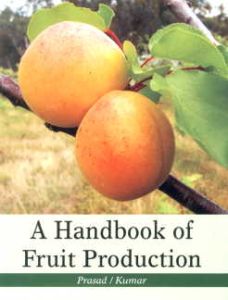
Contents: I. Principles of fruit production: 1. The fruit. 2. Origin, cultivation and status of fruit crops. 3. Fruit growing areas and varieties in India. 4. Fruit set and ripening. 5. Chemical composition and nutritional value of fruits. 6. Fruit cultivation: soils environment. 7. Fruit cultivation: tillage and tillage operations. 8. Fruit cultivation: water relations. 9. Fruit cultivation: water management and irrigation. 10. Nursery practices. 11. Propagation through seeds. 12. Propagation through cuttings. 13. Propagation through layering. 14. Propagation through grafting. 15. Propagation through budding. 16. Weed control of fruit crops. 17. Diseases of fruit crops. 18. Fruit cultivation: pruning. 19. Organic fruit production. 20. Postharvest aspects of fruit crops. 21. Fruit biotechnology. II. Fruit cultivation: 1. Aonla. 2. Apple. 3. Apricot. 4. Avocado. 5. Bael (Bengal Quince). 6. Banana and plantain. 7. Ber. 8. Carambola. 9. Cherry. 10. Date palm. 11. Durian. 12. Egg fruit. 13. Fig. 14. Grape. 15. Guava. 16. Jackfruit. 17. Jamun. 18. Karonda. 19. Kiwi. 20. Limes and lemons. 21. Litchi. 22. Loquat. 23. Macadamia. 24. Mandarin orange. 25. Mango. 26. Mangosteen. 27. Olive. 28. Papaya. 29. Passion fruit. 30. Peach. 31. Pear. 32. Pecan. 33. Phalsa. 34. Pineapple. 35. Plum. 36. Pomegranate. 37. Rambutan. 38. Sapota. 39. Strawberry. III. Appendix: 1. Improved varieties of fruits. 2. Common and botanical names. Glossary. References. Subject index.
"The nature is given to India diverse geographical soil and agro-climate conditions in varies region. Thus it is possible to grow various kinds of fruits in the different states of India. The climate ranges from typical tropics in Kerala to extreme temperate in the high hills of Kashmir, Himachal, U.P., Arunachal Pradesh and Meghalaya. Similarly, Meghalaya get the highest rainfall in the world and Rajasthan get very little rain. It is therefore, possible to grow tropical sub-tropical and temperate fruits in the different regions.
Present book has been designed to provide overall information of principles of fruit production and cultivation of individual important fruits cultivated in India."